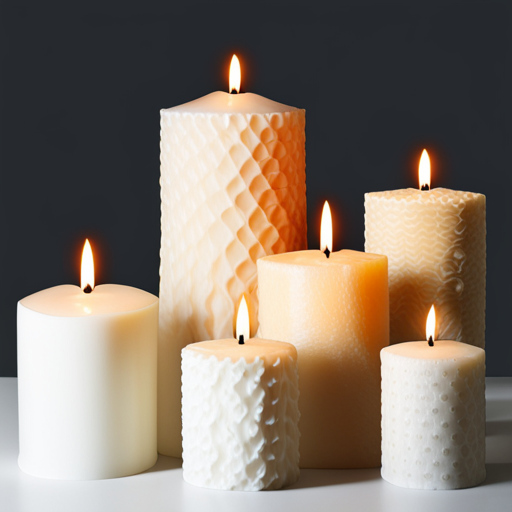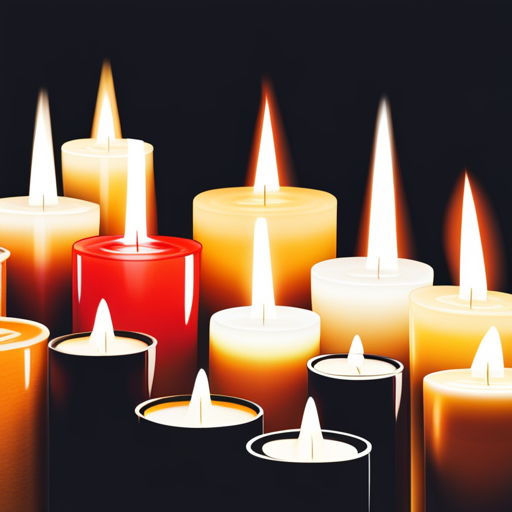In this article, it explores the relationship between scent and burn speed in candles.
It delves into the impact of different types of wax, such as paraffin and soy, on burn time.
Additionally, it compares long lasting and short burn candles, providing tips to extend a candle’s burn time.
Ultimately, this article aims to help readers understand the factors that affect candle burn time and make informed choices when selecting candles.
Key Takeaways
– Unscented candles burn faster than scented candles.
– Some environmentally friendly candles, especially those with wooden wicks, burn slowly.
– Traditional cotton wick candles burn faster than wooden wick candles.
– The burn life of a candle depends more on the wax used than the scent or additional oils.
The Impact of Scent on Burn Speed

https://www.youtube.com/watch?v=B9asozzeAwY
Unscented candles burn faster than scented candles, making scent a factor that affects the burn speed of a candle. When a candle is scented, it contains additional oils and fragrances that can alter the composition of the wax. These added substances can increase the density of the wax, causing it to burn at a slower rate.
On the other hand, unscented candles do not have these additional oils, resulting in a quicker burn time. This is particularly useful in situations where a faster burn is desired, such as during power outages or when using candles for practical purposes like lighting.
However, it is important to note that the scent of a candle can enhance the overall ambiance and atmosphere, so the choice between scented and unscented candles ultimately depends on personal preference.
Understanding the Relationship Between Wax Type and Burn Time

Soy wax, with its higher melting point, allows candles to reach maximum temperature faster than paraffin wax. This can have an impact on the burn time of the candle. Understanding the relationship between wax type and burn time is essential for candle enthusiasts.
Here are some key points to consider:
– Soy wax burns slower than paraffin wax, resulting in a longer-lasting candle.
– Paraffin wax, on the other hand, burns faster, which means the candle may not last as long.
– The choice between soy wax and paraffin wax depends on personal preference and desired burn time.
– The wax type directly affects the overall burn time of the candle, making it an important factor to consider when purchasing candles.
These points highlight the significance of wax type in determining the burn time of candles, evoking a sense of curiosity and interest in the audience.
Comparing Long Lasting and Short Burn Candles

Long lasting candles provide a longer burn time compared to their short burn counterparts, making them a more economical choice for individuals who prefer candles that last. These candles are designed to burn slowly and can stay lit for hours on end, allowing users to enjoy their warm glow and ambiance for an extended period.
On the other hand, short burn candles have a shorter lifespan and may need to be replaced more frequently. While short burn candles may be cheaper upfront, the cost of replacing them adds up over time.
Long lasting candles are a practical option for those who want to save money and avoid the hassle of constantly buying new candles.
Tips for Extending the Burn Time of Scented Candles

To extend the burn time of scented candles, individuals can try placing the candle on a cool surface to prevent overheating. This simple tip can help the candle burn slowly and last longer, allowing individuals to enjoy the scent for a longer period of time.
In addition to this, there are other ways to extend the burn time of scented candles:
– Trim the wick before lighting the candle to ensure a clean and even burn.
– Avoid placing the candle in a drafty area, as this can cause the flame to flicker and burn the wax faster.
– Use a candle snuffer instead of blowing out the flame, as blowing can cause the wax to splatter and burn faster.
– Store scented candles in a cool and dry place, away from direct sunlight, to preserve their fragrance and quality.
Exploring the Factors That Affect Candle Burn Time

Factors such as the type of wax used and the presence of additional oils can significantly impact the burn time of a candle. The type of wax, whether it is paraffin or soy, can determine how quickly the candle burns. Paraffin wax, being a byproduct of oil manufacturing, typically takes longer to reach its maximum temperature compared to soy wax.
Additionally, the presence of additional oils, such as fragrance oils, can also affect burn time. While the amount of wax replaced by fragrance oils is usually negligible, the scent can still impact how the candle burns.
Therefore, it is important to consider these factors when choosing a candle, as they can determine how long the candle will last and how well it will fill the room with its aroma.
Choosing the Right Candle for Your Needs: Scent Vs Burn Performance

The choice between a scented or unscented candle depends on individual preferences and desired burn performance.
– Scented candles create a cozy and inviting atmosphere, filling the room with delightful aromas.
– Unscented candles are perfect for people who prefer a neutral scent or have sensitivities to strong smells.
The scent of a candle can evoke powerful emotions and memories, enhancing relaxation or creating a romantic ambiance.
– The burn performance of scented candles may be affected by the type of wax used and the quality of the fragrance oils.
Ultimately, the decision comes down to personal taste and the desired ambiance. Whether one prefers the soothing scent of lavender or the simplicity of an unscented candle, both options offer their own unique benefits.
Does the Science Behind Scent and Candle Burning Explain Why Candles Lose Their Scent Over Time?
The science behind candles scent longevity surprise is fascinating. Over time, candles lose their scent due to the evaporation of the fragrance oils and the breakdown of the wax. Factors like temperature, sunlight, and airflow can also affect the longevity of a candle’s scent.
Frequently Asked Questions
How Does the Scent of a Candle Affect Its Burn Time?
The scent of a candle does not directly affect its burn time. Factors such as the type of wax, wick, and environmental conditions play a more significant role in determining how long a candle will burn.
Can Scented Candles With Wooden Wicks Burn as Slowly as Unscented Candles?
Scented candles with wooden wicks can burn as slowly as unscented candles. Factors such as the type of wax used and the wick’s material can influence burn time. Understanding these factors helps in choosing the right candle.
Is There a Difference in Burn Time Between Scented Candles Using Paraffin Wax and Those Using Soy Wax?
There is a difference in burn time between scented candles using paraffin wax and those using soy wax. Soy wax has a higher melting point and takes longer to reach maximum temperature, resulting in a longer burn time.
Are Long Lasting Scented Candles More Expensive Than Short Burn Scented Candles?
Long lasting scented candles may be more expensive upfront compared to short burn scented candles. However, they are more economical in the long run as they don’t need to be replaced as often.
How Can I Choose the Right Scented Candle That Balances Both Scent and Burn Performance?
To choose a scented candle that balances both scent and burn performance, consider factors like the wax type, wick material, and burn time. Experiment with different options to find the perfect combination for your needs and preferences.

